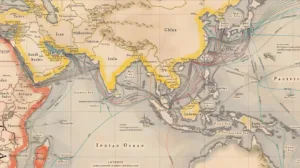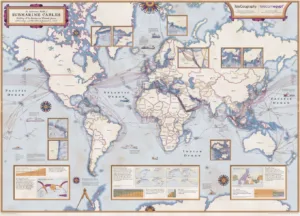Internet Traffic through the Ocean
The internet traffic travels underwater and at the bottom of the oceans through almost 1.5 million km of submarine fiber optic cables. It can be safely said that 99% of all international internet data is transferred through a labyrinth of cables stretching along the seabed which is crisscrossed with 229 transatlantic fibre optic cables or subsea cables with each cables measuring between 0.8 and 1.2 inches .
Transatlantic Subsea Cables Origin
As far back as 1886 the ship SS Great Eastern was the first to lay a continually successful transatlantic cable. The fastest and newly completed transatlantic fibre optic cable called Amitie is funded by Microsoft, Meta and others capable of transmitting 400 terabits of data/sec almost 400,000 times faster then the household broadband . Trillions of dollars of daily transactions signifies that the global economy hinges around subsea fiber optic cables. Subsea cables are low-tech as well coated in tar and unspooled by ships employing essentially the same process used a century ago when the first transatlantic internet cable was laid.
 Credit ;Vox.com
Credit ;Vox.com
US Economic and Military Dominance Challenged by China’s Entry into Subsea Cables Market
The United States is the most digitally connected country with numerous cables linking it to most other continents. The United Kingdom, Senegal and Nigeria are large internet connection hubs. The United States’ financial and military command and control systems rely on global submarine cables. The Chinese initially penetrated the global sub sea fiber cable regime which was countered by consecutive US Presidencies ostensibly on account of espionage paranoia or concerns .The US administration is apprehensive that Chinese companies might disrupt strategic assets operated by it in the event of a conflict which is presently a remote probability .Despite being routinely blocked from international subsea cable projects involving US investment Chinese companies have adjusted their business strategies by building international cables for China and countries with which is has strategic linkages. To date the US has succeeded in preventing China from entering the global submarine cable market in a big way. So far the Chinese supplier HMN Tech has provided or is poised to provide the equipment to only 10 % of all existing and planned global cables where the supplier is known.
 Credit ; Kentic.com
Credit ; Kentic.comDepth of Subsea Fiber Cables
Submarine Fiber Optic Routes Aligned with Economic Routes
Despite the hype of satellite internet connectivity transatlantic subsea cables are the technology of choice today primarily because of their stability and reliability. Large undersea cables costs extend to hundreds of millions of dollars and are invariably funded by a consortium of tech or telecom companies that can diversify and absorb the cost and risks. Subsea fiber cables between South America and Africa for instance are more scarce than trans-Atlantic and trans-Pacific routes which reflects economic activity or economic routes as well.
There are 6 international submarine cable systems connecting Pakistan, including SMW3, SMW4, SMW5, IMEWE, AAE-1 and TW1. The Orient Express and PEACE cable systems are under construction with the latter submarine cable system presently having two landing sites in Pakistan, at Gwadar and Karachi which will span Africa and Europe. The PEACE submarine fiber optic cable system has been constructed by China Huawei. The PEACE submarine cable system is China’s pursuit for internet connectivity to the untapped African markets, a 15,000 km submarine cable from Pakistan to France, extending from Pakistan to Singapore for an additional 6,500km, with main trunk landing in Singapore, Pakistan, Kenya, Egypt and France and branches to the Maldives, Malta, Cyprus, etc. Transworld (TWA) Karachi Cable Landing Station (TWA Karachi CLS) is located at Sector 54 Hawkes Bay Town, Goth Lashkari, Karachi ,Pakistan. TWA Karachi CLS is the cable landing station for TW1 and SMW5 cable systems. The TW1 cable system is a private cable owned by Transworld . In the year 2022 Pakistan & East Africa Connecting Europe (PEACE) Cable International Network Co. Ltd completed the construction of a submarine cable infrastructure enabling connectivity from Karachi to Marseille, France which is a global internet hub. The Pakistan-Egypt segment connects Karachi and Zafarana, Egypt total length being 5,800 KM. The connectivity from Pakistan to France is now fully complete.The Pakistan Telecommunication Company Limited (PTCL) has announced a new undersea fibre-optic cable likely to come online by 2026. The Africa-1 Submarine Cable will be connected to PTCL’s landing station at Karachi Seaview.The project cost is around USD $59 and the initiative is designed to enhance internet connectivity between the UAE, Europe and Africa accompanied by multiple landing stations along the route.
Pakistan can become a regional and transatlantic internet and digital hub by arranging more fiber optic cables to arrive at the coast of Karachi and extending along the hinterland to enter Afghanistan, Central Asian countries and upto the Chinese heartland .
Co-Authored by Nadir Mumtaz & Razeen Ahmed
Credit:Source
https://ig.ft.com/subsea-cables/
https://www.vox.com/2015/3/13/8204655/submarine-cables-internet
https://www.weforum.org/agenda/2016/01/how-does-the-internet-cross-the-ocean/
https://edition.cnn.com/2024/03/08/opinions/undersea-cables-resilience-salgado/index.html

Leave A Comment